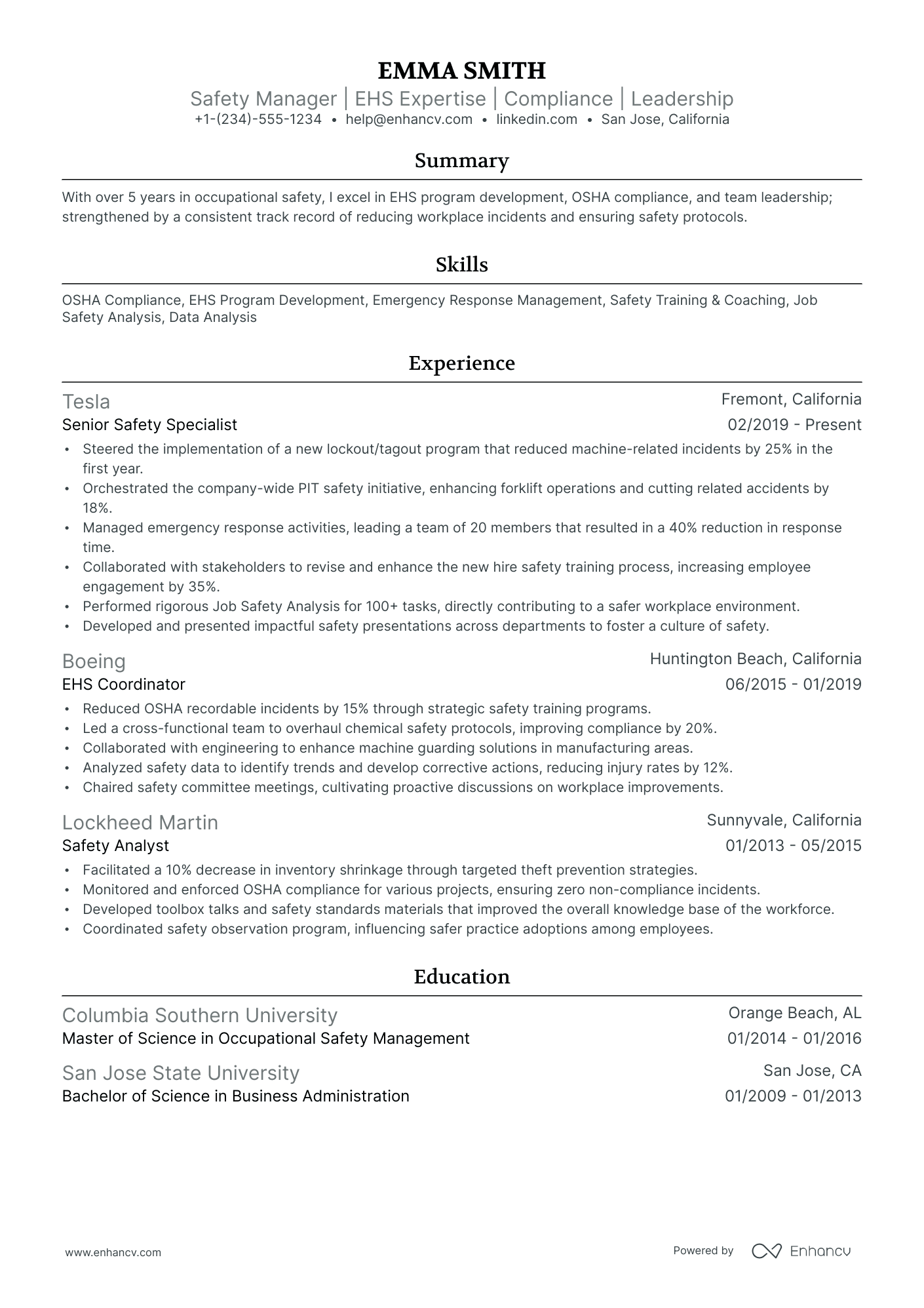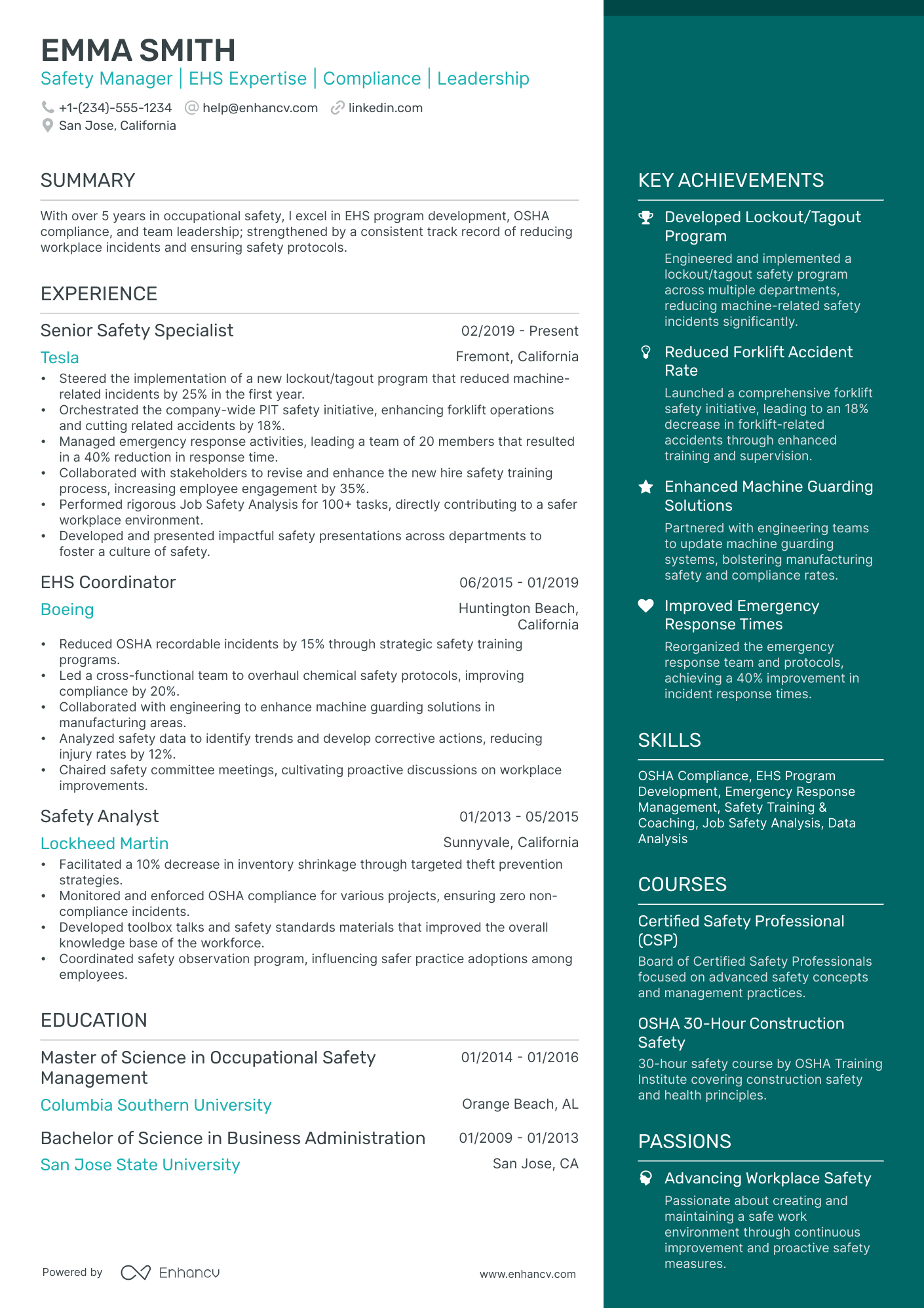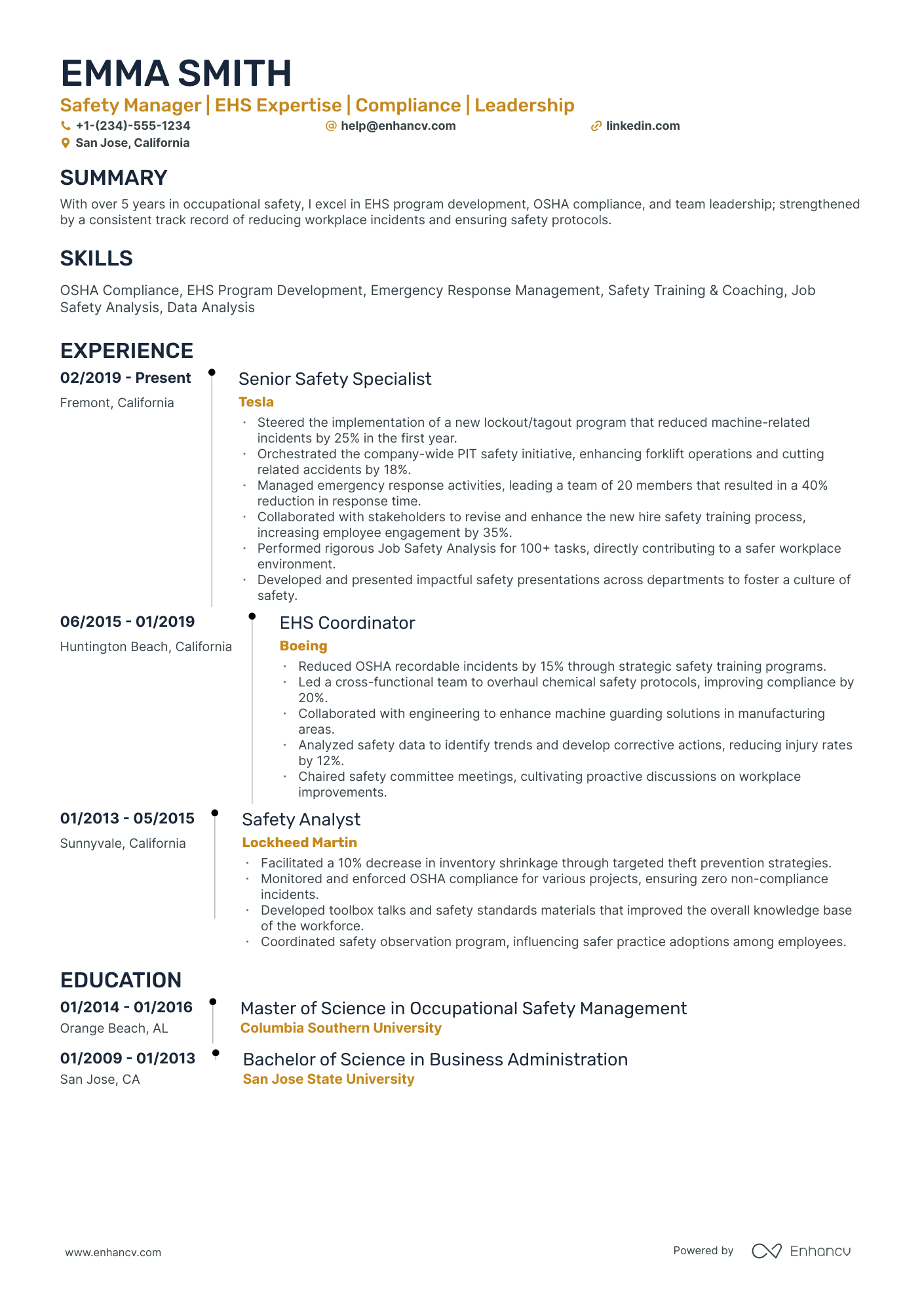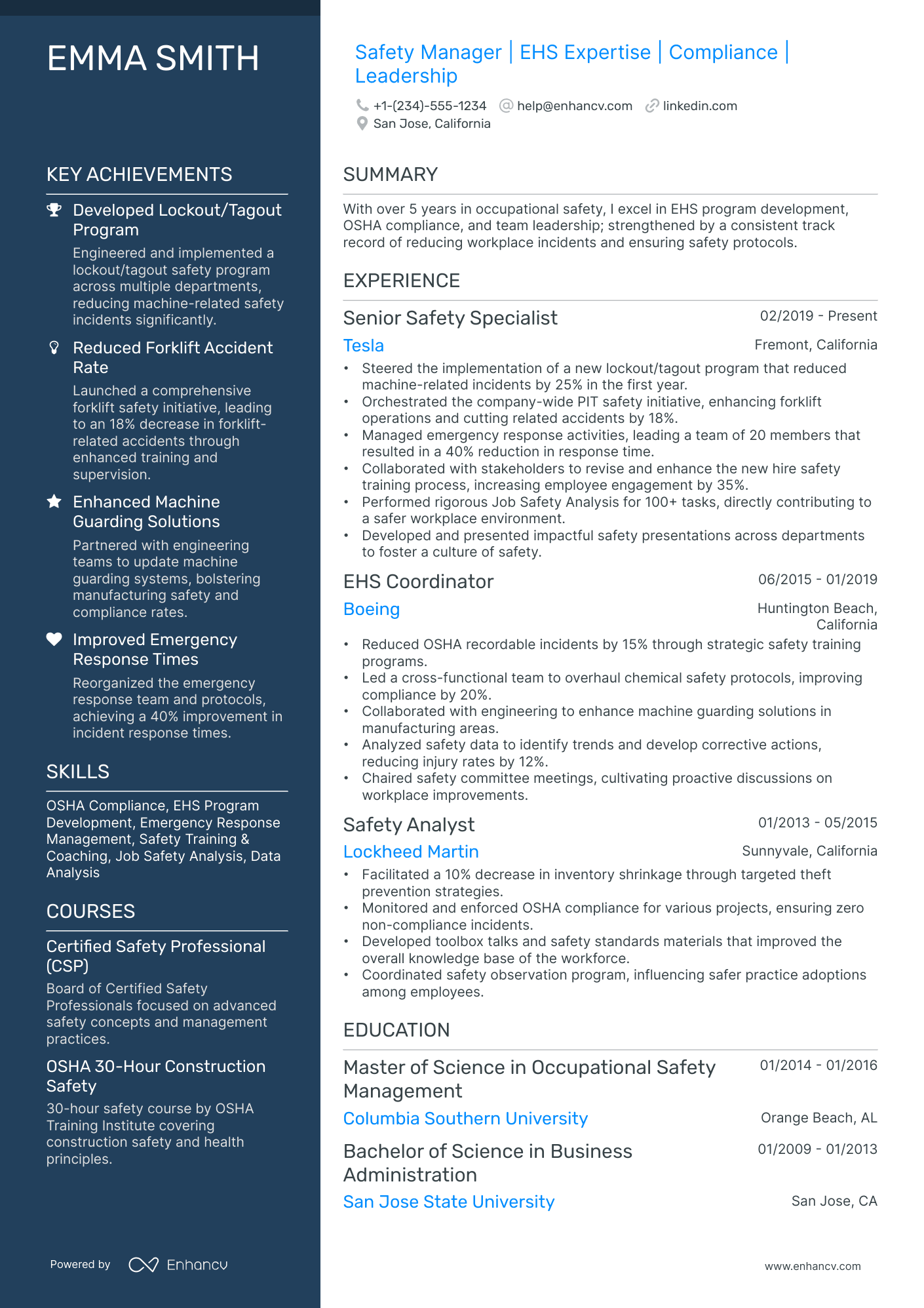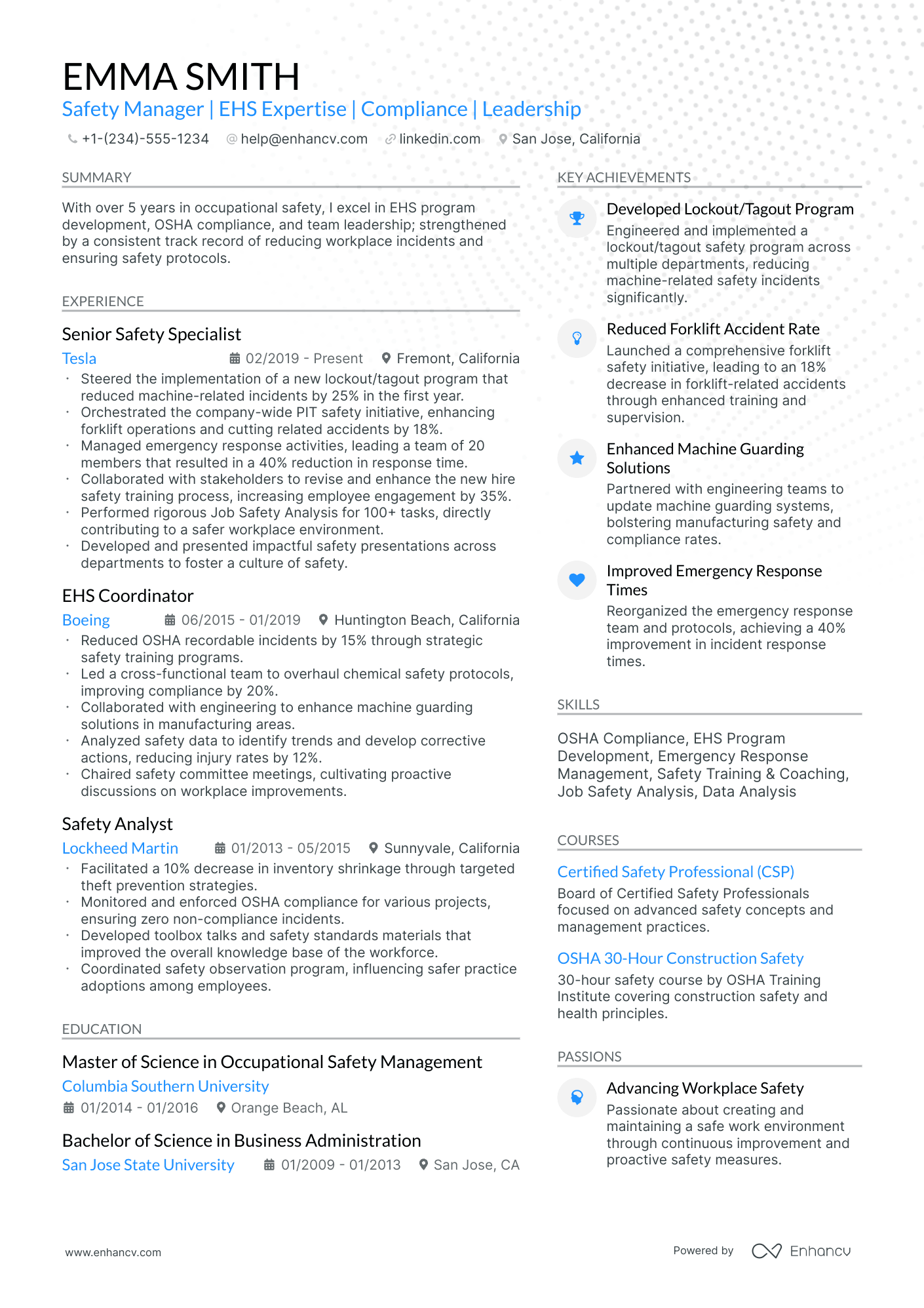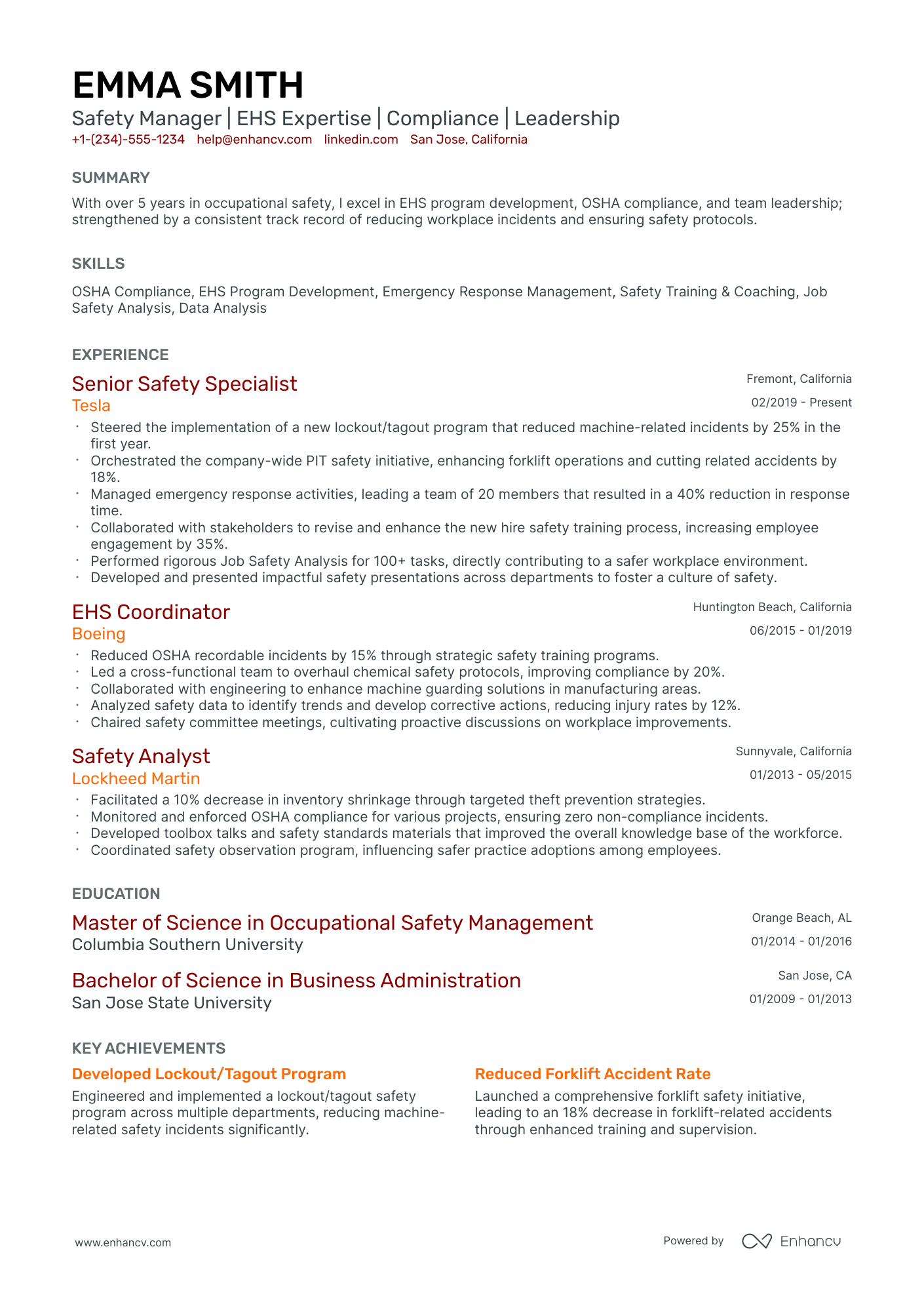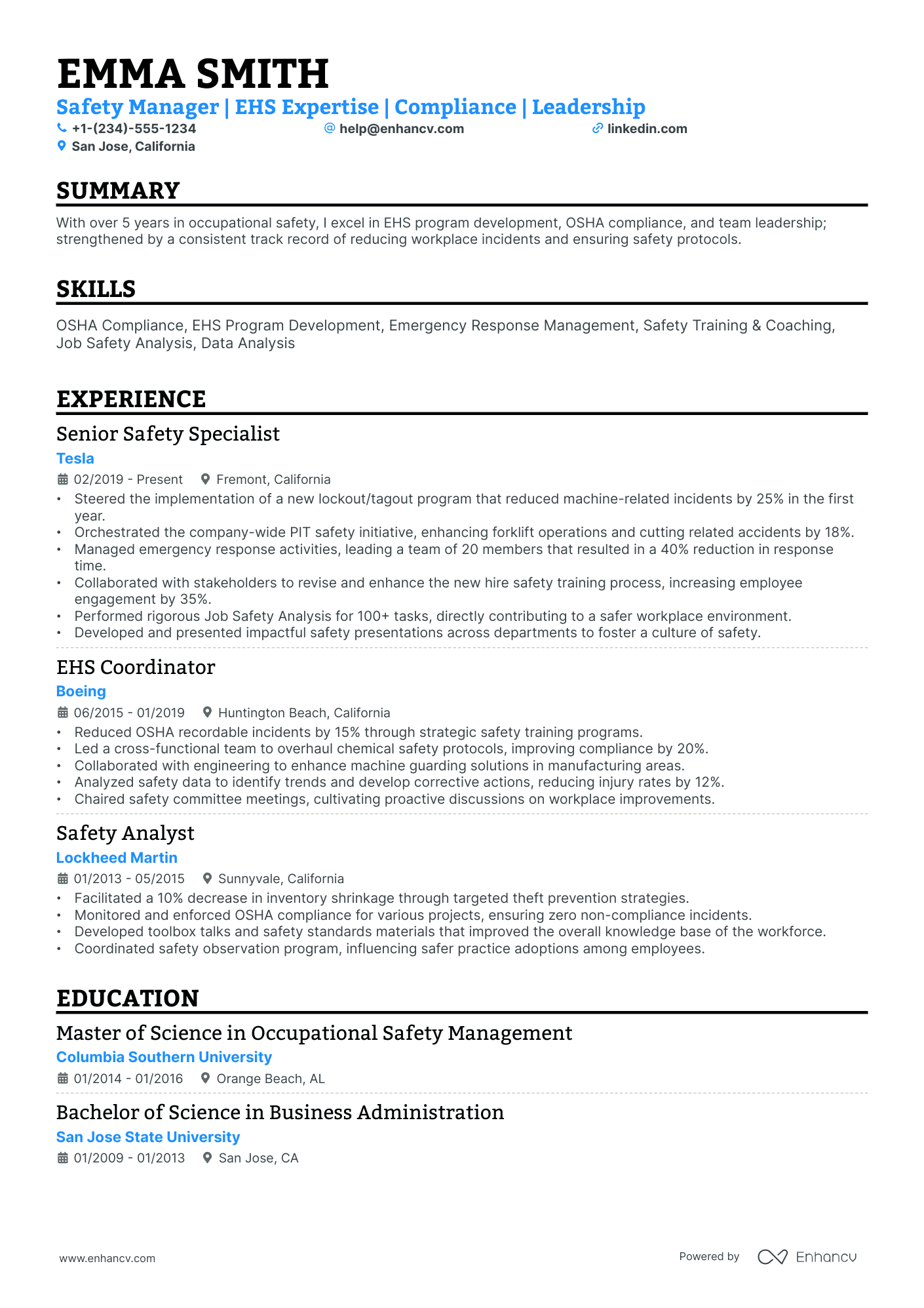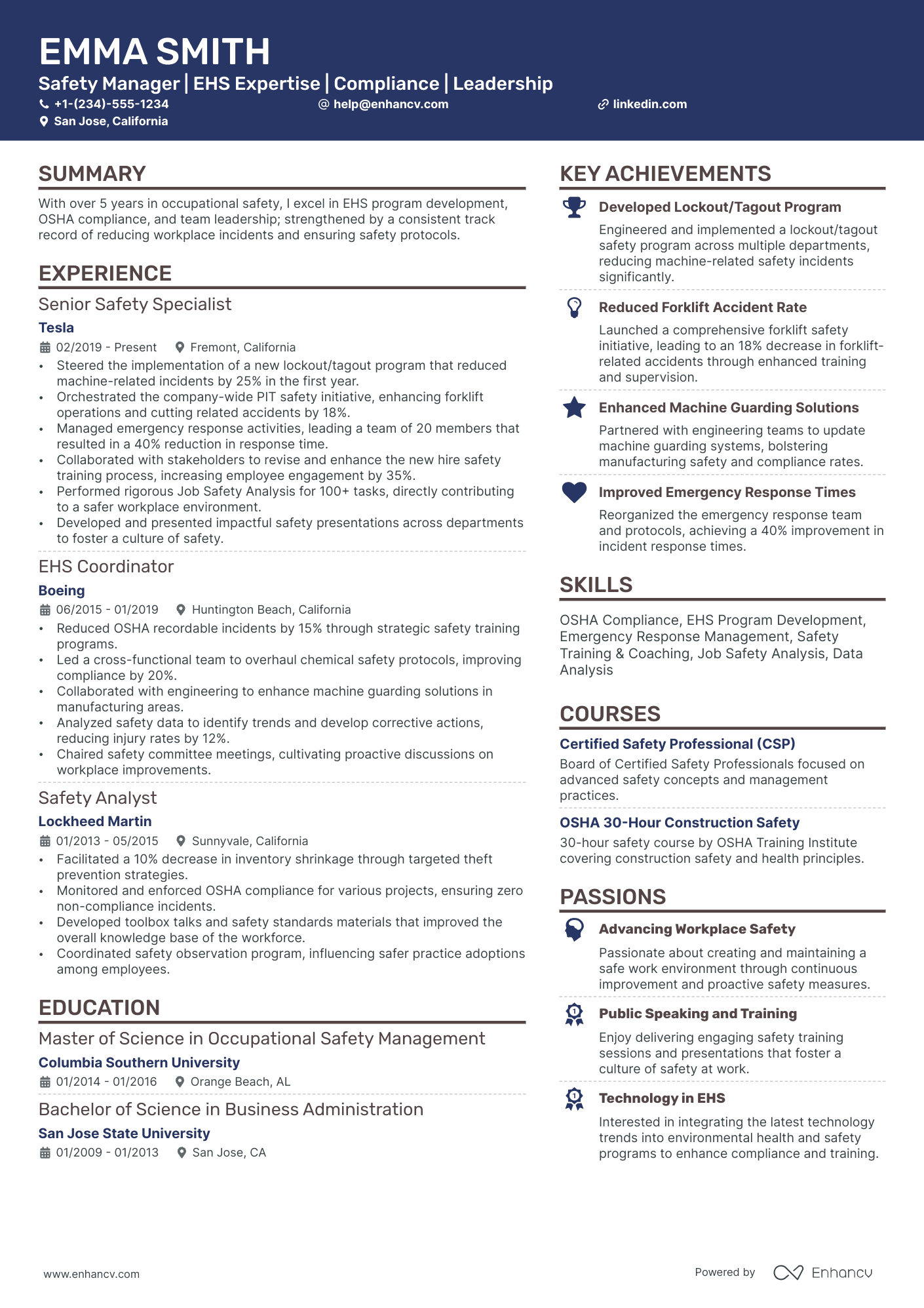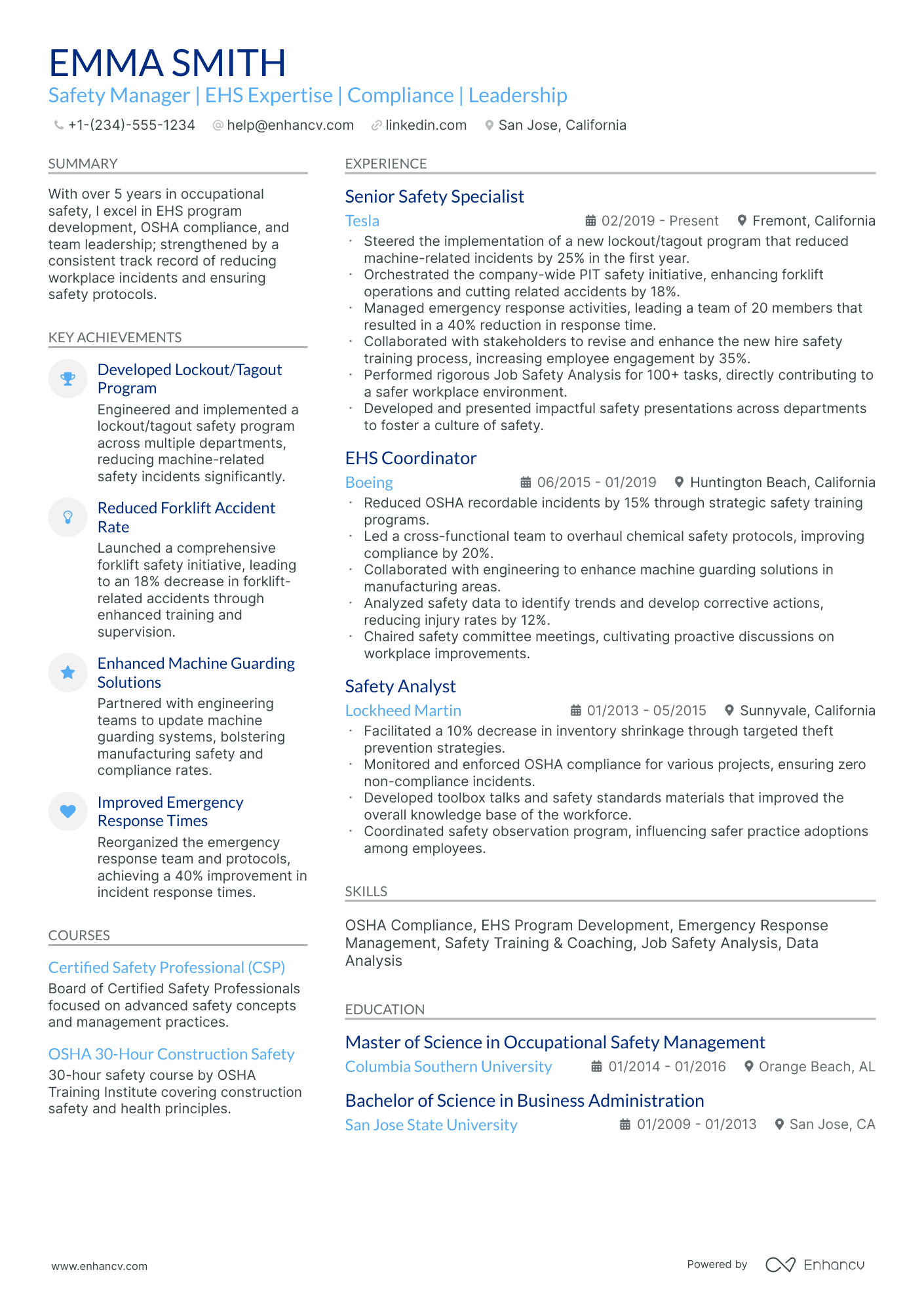As a safety manager, articulating the breadth and depth of your hands-on experience with complex safety protocols can be a daunting resume challenge. Our guide is here to help you streamline this information, ensuring that your resume clearly and effectively showcases your expertise to potential employers.
- Format your safety manager resume to ensure that it balances professionalism with creativity, and follows the best practices.
- Match the safety manager job requirements by including industry keywords on your resume.
- Use various resume sections to showcase your skills and achievements to answer why you're the best candidate for the safety manager role.
Take inspiration from leading safety manager resume examples to learn how to tailor your experience.
- Demand Planning Manager Resume Example
- Business Project Manager Resume Example
- Resource Manager Resume Example
- Banking Business Analyst Resume Example
- Implementation Manager Resume Example
- Entry Level Business Analyst Resume Example
- Healthcare Business Analyst Resume Example
- Investment Manager Resume Example
- Logistics Account Manager Resume Example
- Strategic Sourcing Manager Resume Example
Is there a correct way to format your safety manager resume?
This is a tricky question. While skimming over your resume, recruiters will be looking at your experience and the message your profile conveys. That's why your resume format needs to be clear and concise, serving to supplement and organize your experience. Professional best practices point that the best safety manager resumes:
- Follow the reverse chronological order, where the most recent experience items are presented first . This is to keep your expertise succinct and to show recruiters your career growth over the years;
- Have a clearly defined header that includes all relevant contact information and a portfolio or a LinkedIn link. In some countries, it is acceptable to include a professional photo , so that your application is more memorable;
- Feature the most important safety manager resume sections towards the top, e.g. summary, skills, and experience. That way, recruiters can immediately find information that is relevant to the role;
- Take up no more than two pages - and two pages are the exception for more experienced professionals. Keep your expertise to the point and use your safety manager resume real estate wisely .
- Selecting modern, yet simple fonts, e.g. Rubik, Lato, etc., would help your application stand out;
- Many candidates stick with the tried-and-tested Arial or Times New Roman, but you'd want your safety manager resume to be a bit more unique;
- The ATS can read all serif and sans-serif fonts, so you should avoid fancy, formal script (or cursive) fonts.
Keep in mind market-specific formats – for example, a Canadian resume might follow a different structure.
Upload & Check Your Resume
Drop your resume here or choose a file. PDF & DOCX only. Max 2MB file size.
PRO TIP
Highlight any significant extracurricular activities that demonstrate valuable skills or leadership.
The five (plus) definite sections your resume for a safety manager job should include are:
- Header with your headline, contact details, and/or a preview of your work
- Summary (or objective) to pinpoint how your success aligns with the role
- Experience with bullets of your most relevant achievements in the field
- Skills to integrate vital job requirements (both technical and personal)
- Your further dedication to the field, showcased via relevant higher education and/or certifications
What recruiters want to see on your resume:
- Demonstrated knowledge of OSHA, EPA, and other relevant safety regulations and standards.
- Experience in developing and implementing safety training programs and emergency response plans.
- Proven track record of reducing workplace incidents and maintaining compliance through regular safety audits and risk assessments.
- Strong leadership skills and experience in managing safety committees or teams.
- Expertise in incident investigation, root cause analysis, and implementation of corrective actions to prevent recurrence.
Quick guide to your safety manager resume experience section
After deciding on the format of your resume, it's time to organize your experience within the dedicated section.
It's common for safety manager professionals to be confused in this part of the process, as they may have too much or little expertise.
Follow the general rules of thumb to be successful when writing this part of your resume:
- The perfect number of bullets you should have under each experience item is no more than six;
- Select not merely your responsibilities, but the most noteworthy achievements for each role that match the job requirements;
- List any certificates or technical expertise you've gained on the job and how they've helped you progress as a professional;
- Carefully select the power verbs to go along with each bullet to avoid generic ones like "managed" and instead substitute those with the actuality of your particular responsibility;
- Integrate valuable keywords from the job advert in the form of achievements under each role you list.
If you're on the search for further advice on how to write your safety manager experience section, get some ideas from real-world professional resumes:
- Implemented comprehensive safety training programs for over 500 employees, ensuring adherence to OSHA standards and reducing workplace accidents by 40%.
- Directed a cross-departmental team to analyze and revamp emergency response procedures, which led to a 25% improvement in response time.
- Negotiated with safety equipment suppliers to enhance PPE quality while cutting costs by 15%, improving overall workforce protection.
- Orchestrated the successful certification of the company under ISO 45001, which led to a pronounced boost in brand reputation and client trust.
- Analyzed incident and near-miss reports to identify trends and implemented preventive measures, reducing incident rate by 30% over three years.
- Collaborated with engineering teams to redesign workplace layouts, enhancing safety and ergonomics, resulting in a 20% decrease in ergonomic-related complaints.
- Championed the development of a safety-focused culture that embraced continuous improvement, achieving a record low of LTIs (Lost Time Injuries) for two consecutive years.
- Led the integration of cutting-edge wearable safety technology which monitored employees' vitals in high-risk environments, thereby minimizing health-related incidents.
- Forged strong relationships with regulatory agencies, ensuring compliance and securing a 100% audit pass rate through meticulous preparation and company-wide engagement.
- Devised a strategic safety management system that aligned with corporate objectives, successfully reducing recordable incidents by over 50% across multiple sites.
- Initiated a transparent incident reporting platform that encouraged employee participation and led to the early detection of potential hazards.
- Deployed a fleet safety program for the company's delivery network that decreased transportation incidents by 35% while increasing driver safety awareness.
- Engineered a behavioral safety program that incentivized safe practices among employees, resulting in a 60% drop in behavior-related accidents.
- Implemented a robust hazardous materials management plan, ensuring the safe handling, storage, and disposal of chemicals across the company's regional branches.
- Successfully navigated the challenges of maintaining a zero-accident work environment during the scaling of operations by 200%.
- Pioneered an innovative risk assessment tool that projected potential safety risks using AI, which reduced downtime due to accidents by over 25%.
- Coordinated with production teams to install safety automation systems, leading to a 15% boost in overall equipment effectiveness (OEE).
- Established a contractor safety management framework that heightened control measures and accountability, slashing contracting-related incidents by 45%.
- Streamlined the company's safety data analysis process, integrating a comprehensive digital reporting system that improved data accuracy and reporting efficiency by 30%.
- Curated and led a safety leadership training module for mid-level managers, empowering them to embed safety considerations into daily operations and decision-making.
- Managed the successful transition to a proactive safety strategy, which reduced the company's Workers' Compensation claims frequency by 20%.
- Formulated and executed a strategic plan for global safety standards across the company's international locations, leading to a standardized safety protocol and a 25% decrease in cross-border safety incident variance.
- Drove a 40% reduction in overall safety incidents through the implementation of an advanced analytics program for predicting and preventing workplace accidents.
- Partnered with external safety consultants to conduct yearly audits, which enhanced compliance with industry safety regulations and reduced potential legal liabilities.
The following content includes information from "O*NET OnLine" by the U.S. Department of Labor, Employment and Training Administration (USDOL/ETA). Used under the CC BY 4.0 license. The data represents the top responsibilities present on the task lists for safety manager professionals.
Top Responsibilities for Safety Manager:
- Analyze and evaluate security operations to identify risks or opportunities for improvement through auditing, review, or assessment.
- Assess risks to mitigate potential consequences of incidents and develop a plan to respond to incidents.
- Attend meetings, professional seminars, or conferences to keep abreast of changes in executive legislative directives or new technologies impacting security operations.
- Communicate security status, updates, and actual or potential problems, using established protocols.
- Conduct physical examinations of property to ensure compliance with security policies and regulations.
- Conduct threat or vulnerability analyses to determine probable frequency, criticality, consequence, or severity of natural or man-made disasters or criminal activity on the organization's profitability or delivery of products or services.
- Coordinate security operations or activities with public law enforcement, fire and other agencies.
- Create or implement security standards, policies, and procedures.
- Develop budgets for security operations.
- Develop or manage investigation programs, including collection and preservation of video and notes of surveillance processes or investigative interviews.
Quantifying impact on your resume
- Quantify the reduction of workplace incidents under your management to highlight the effectiveness of your safety programs.
- Include the percentage decrease in workers' compensation claims to demonstrate cost savings from improved safety measures.
- Detail the number of safety audits conducted and any subsequent policy changes implemented to show proactive leadership.
- Specify the size of the team you've led for safety training sessions to illustrate your management and organizational skills.
- Mention the budget size you've managed for safety improvements to underscore your financial responsibility.
- Outline the number of regulatory compliance requirements you've consistently met or exceeded to establish your industry knowledge.
- Provide the number of safety workshops or seminars you've developed or instructed to present your expertise in safety education.
- List measurable improvements in safety culture, such as increased reporting rates of near-misses or hazards, to show long-term impact.
Action verbs for your safety manager resume
Guide for safety manager professionals kicking off their career
Who says you can't get that safety manager job, even though you may not have that much or any experience? Hiring managers have a tendency to hire the out-of-the-blue candidate if they see role alignment. You can show them why you're the best candidate out there by:
- Selecting the functional skill-based or hybrid formats to spotlight your unique value as a professional
- Tailoring your safety manager resume to always include the most important requirements, found towards the top of the job ad
- Substituting the lack of experience with other relevant sections like achievements, projects, and research
- Pinpoint both achievements and how you see yourself within this specific role in the safety manager resume objective.
Recommended reads:
PRO TIP
If you failed to obtain one of the certificates, as listed in the requirements, but decide to include it on your resume, make sure to include a note somewhere that you have the "relevant training, but are planning to re-take the exams". Support this statement with the actual date you're planning to be re-examined. Always be honest on your resume.
Featuring your hard skills and soft skills on your safety manager resume
The skills section of your safety manager resume needs to your various capabilities that align with the job requirements. List hard skills (or technical skills) to showcase to potential employers that you're perfectly apt at dealing with technological innovations and niche software. Meanwhile, your soft skills need to detail how you'd thrive within your new, potential environment with personal skills (e.g. resilience, negotiation, organization, etc.) Your safety manager resume skills section needs to include both types of skills to promote how you're both technical and cultural fit. Here's how to create your bespoke safety manager skills section to help you stand out:
- Focus on skill requirements that are listed toward the top of the job advert.
- Include niche skills that you've worked hard to obtain.
- Select specific soft skills that match the company (or the department) culture.
- Cover some of the basic job requirements by including important skills for the safety manager role - ones you haven't been able to list through the rest of your resume.
Get inspired with our safety manager sample skill list to list some of the most prominent hard and soft skills across the field.
Top skills for your safety manager resume:
OSHA Regulations
Risk Assessment Tools
Safety Management Systems (SMS)
Incident Investigation Software
Environmental Health and Safety (EHS) Software
Data Analysis Tools
Safety Training Programs
Emergency Response Planning
Personal Protective Equipment (PPE) Standards
Safety Auditing Tools
Leadership
Communication
Problem-Solving
Attention to Detail
Critical Thinking
Team Collaboration
Adaptability
Conflict Resolution
Time Management
Decision Making
Next, you will find information on the top technologies for safety manager professonals from "O*NET OnLine" by the U.S. Department of Labor, Employment and Training Administration (USDOL/ETA). Used under the CC BY 4.0 license.
Top technologies for Safety Manager’s resume:
- Incident command system ICS software
- Microsoft Project
- Microsoft PowerPoint
- Alarm system software
- Maintenance management software
PRO TIP
If you failed to obtain one of the certificates, as listed in the requirements, but decide to include it on your resume, make sure to include a note somewhere that you have the "relevant training, but are planning to re-take the exams". Support this statement with the actual date you're planning to be re-examined. Always be honest on your resume.
The safety manager resume sections you may underestimate: certifications and education
Your education and certifications provide insight into both your technical capabilities and personal attributes, such as perseverance. When crafting your safety manager resume, consider how you present these elements:
- For your higher education degrees, prioritize listing those most relevant to the job or indicative of your academic dedication;
- Include applicable coursework as a stand-in for relevant experience or if it might impress recruiters;
- Include incomplete higher education only if it's pertinent to meeting job requirements;
- If your degree is from a renowned university, mention how often you made the Dean's list to underline academic excellence.
Regarding certifications, it's not necessary to list all of them. Instead, match up to three of your most recent or significant certificates with the technical skills required in the job description.
Below, we've selected some of the top industry certifications that could be vital additions to your safety manager resume.
The top 5 certifications for your safety manager resume:
- Certified Safety Professional (CSP) - Board of Certified Safety Professionals (BCSP)
- Occupational Health and Safety Technologist (OHST) - Board of Certified Safety Professionals (BCSP)
- Associate Safety Professional (ASP) - Board of Certified Safety Professionals (BCSP)
- Construction Health and Safety Technician (CHST) - Board of Certified Safety Professionals (BCSP)
- Certified Industrial Hygienist (CIH) - American Board of Industrial Hygiene (ABIH)
The content below includes information from "O*NET OnLine" by the U.S. Department of Labor, Employment and Training Administration (USDOL/ETA). Used under the CC BY 4.0 license. The data represents the top associations for safety manager professionals.
Top US associations for a Safety Manager professional
- ASIS International
- International Organization of Black Security Executives
- American Society of Safety Professionals
- ARMA International
- Association of Threat Assessment Professionals
PRO TIP
If you happen to have some basic certificates, don't invest too much of your safety manager resume real estate in them. Instead, list them within the skills section or as part of your relevant experience. This way you'd ensure you meet all job requirements while dedicating your certificates to only the most in-demand certification across the industry.
Recommended reads:
Best practices to your safety manager resume summary or objective
To start, how do you know if you should include a resume summary or a resume objective ?
- Resume summaries are ideal for safety manager professionals with more experience, who'd like to give a quick glimpse of their biggest career achievements in the top one-third of their resumes.
- On the other hand, resume objectives serve as a road map for recruiters. Candidates use the objective to show how their experience aligns with the safety manager role they're applying for while showcasing the North Star of their career (or where they want to be as a professional in the next couple of years).
The resume summary or resume objective could be the perfect fit for your safety manager resume. The function of both is to highlight your professionalism succinctly. So, keep your writing specific: include no more than four sentences and target your application to the role. Here's how these specific resume sections help the safety manager candidates stand out.
Resume summaries for a safety manager job
- With over 10 years of experience in industrial safety management, the candidate has developed a robust skill set including risk assessment, emergency response planning, and OSHA compliance. Successfully reduced workplace accidents by 40% in a high-risk manufacturing environment through the implementation of a comprehensive safety training program.
- Former aerospace engineer with 8 years of project management experience, seeking to transition into safety management. Holds a Six Sigma Green Belt certification and leverages exceptional analytical skills to identify and mitigate risks. Proven track record in enhancing system safety protocols leading to a 15% reduction in safety incidents over two years.
- Dedicated professional with extensive experience in healthcare administration and a nursing background, aiming to pivot into a safety manager role. Proficient in patient safety initiatives, regulatory compliance, and staff training, having spearheaded a cross-departmental campaign that cut down infection rates by 25%.
- Aspiring to apply my strong foundation in construction management and education in occupational health and safety towards fostering safe work environments. Exceptionally motivated by the prospect of ensuring adherence to industry safety standards and eager to contribute to significant reductions in workplace hazards and accidents.
- Armed with a solid understanding of environmental health from an academic standpoint and eager to translate this knowledge into practical application. Keen to embark on a career as a safety manager, with a focus on implementing sustainable practices that ensure employee well-being and compliance with environmental regulations.
- Bringing forth 15 years of dedicated experience in the oil and gas industry with a focus on operational safety. Adept in hazard identification, incident investigation, and safety policy development. Instrumental in reducing Lost Time Injury Frequency (LTIF) rate by 60% through strategic leadership and the deployment of a behavioral-based safety program.
Optimize your resume summary and objective for ATS
Drop your resume here or choose a file.
PDF & DOCX only. Max 2MB file size.
Average salary info by state in the US for safety manager professionals
Local salary info for Safety Manager.” Source: My Next Move, National Center for O*NET Development. Accessed 10/15/2024
| State | Average Salary (in USD) |
|---|---|
| US National Average | $102,340 |
| California (CA) | $110,080 |
| Texas (TX) | $100,890 |
| Florida (FL) | $94,500 |
| New York (NY) | $125,720 |
| Pennsylvania (PA) | $99,580 |
| Illinois (IL) | $102,250 |
| Ohio (OH) | $95,300 |
| Georgia (GA) | $109,790 |
| North Carolina (NC) | $98,110 |
| Michigan (MI) | $92,310 |
Four more sections for your safety manager resume
Your safety manager resume can be supplemented with other sections to highlight both your personality and efforts in the industry. Use the ones you deem most relevant to your experience (and the role):
- Awards - to celebrate your success;
- Interests - to detail what you're passionate about outside of work (e.g. music, literature, etc.);
- Publications - to show your footprint in the wider community;
- Projects - to pinpoint noteworthy achievements, potentially even outside of work.
Key takeaways
- Your resume layout plays an important role in presenting your key information in a systematic, strategic manner;
- Use all key resume sections (summary or objective; experience; skills; education and certification) to ensure you’ve shown to recruiters just how your expertise aligns with the role and why you're the best candidate;
- Be specific about listing a particular skill or responsibility you've had by detailing how this has helped the role or organization grow;
- Your personality should shine through your resume via the interests or hobbies, and strengths or accomplishments skills sections;
- Certifications go to provide further accreditation to your technical capabilities, so make sure you've included them within your resume.
